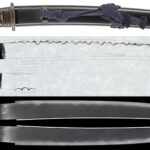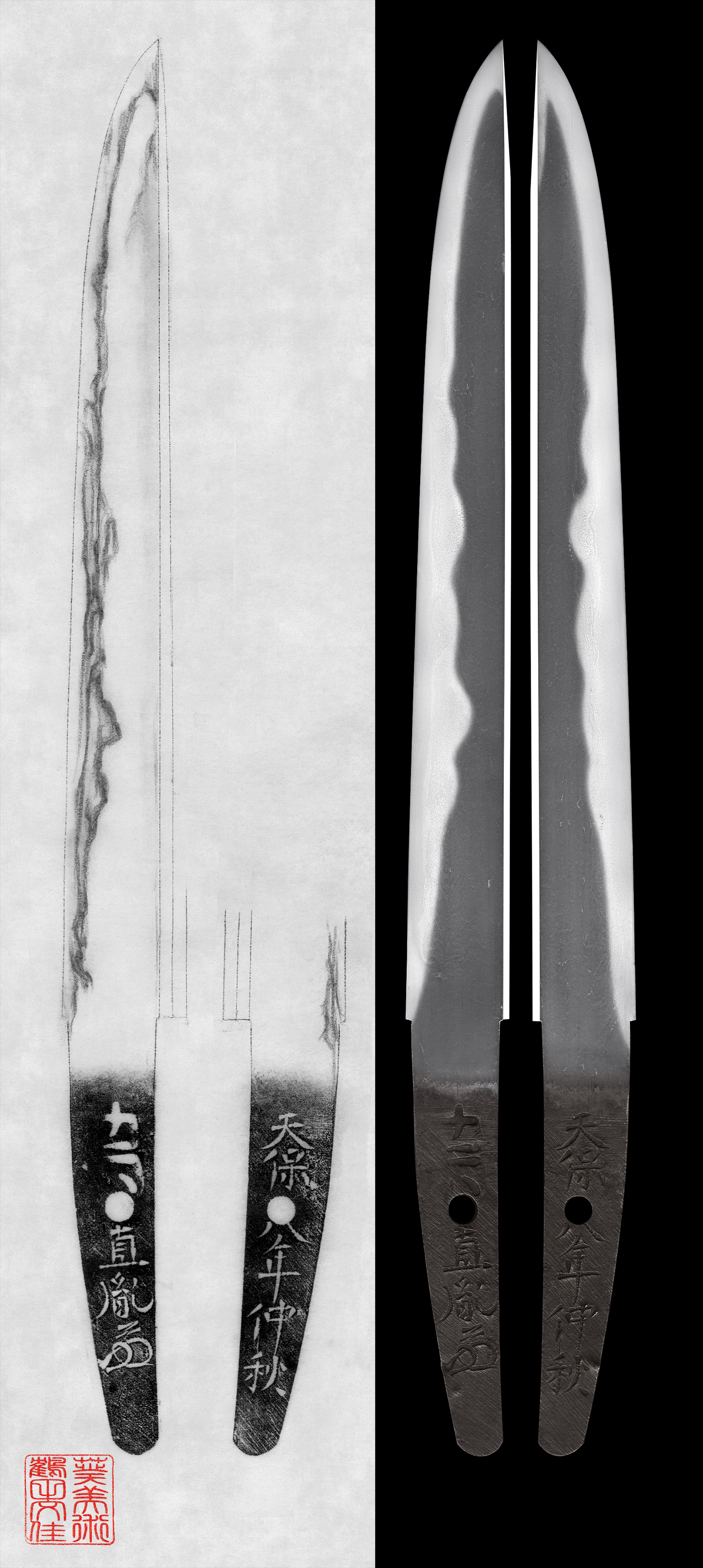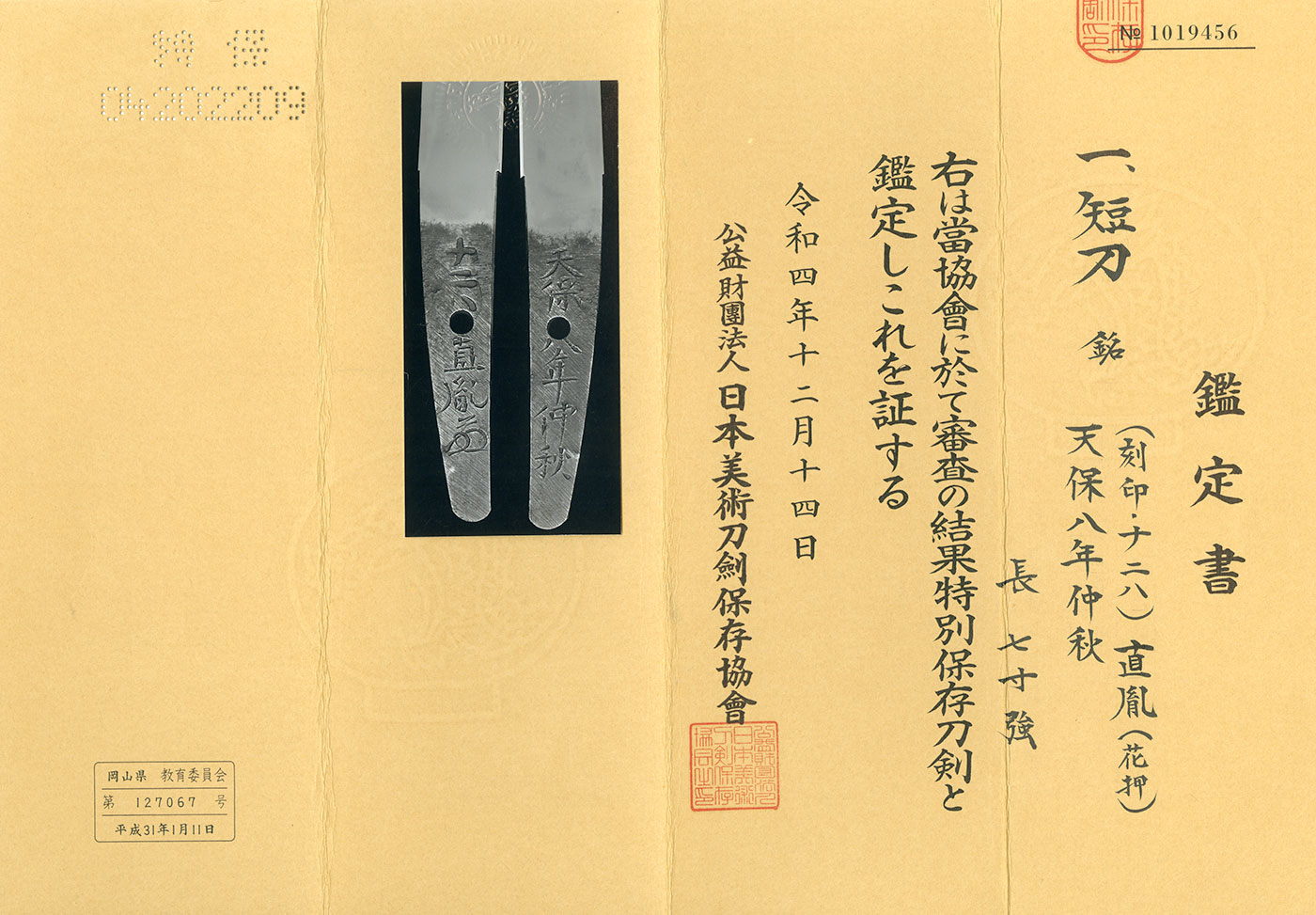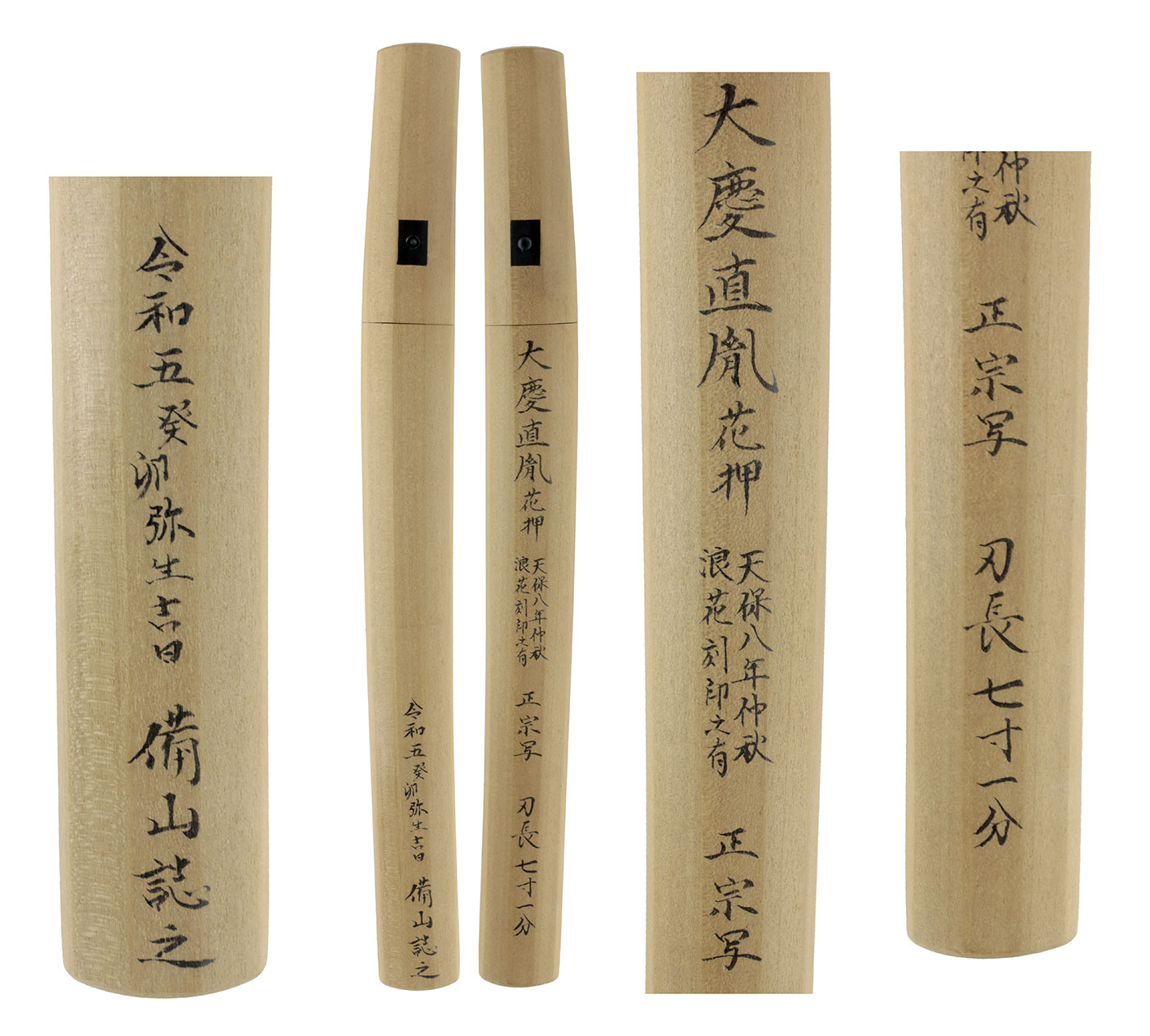Ordering number: 23188
Tanto: In Shirasaya(NBTHK Tokubetsu Hozon Token) (In a Wooden Box)
Inscription: (stamp: Na Ni Ha) Naotane(Kao)
(刻印ナニハ)直胤(花押)
Tempo 8 Nen Chu Shu
天保八年仲秋
Saya (Scabbard Inscription): Taikei Naotane Kao Tenpō 8th Year Autumn, Naniwa, trace of Masamune. The length: 7 Sun 1 Bu. Written by Bizan on a lucky day in March of Reiwa 5(2023)
In our company, we classify swords as Saijo-saku (highest quality), Jojosaku (high quality), Jō-saku (good quality), and Futsū-saku (ordinary quality) based on the craftsmanship of the swordsmith. This piece is ranked as Jō-saku, indicating it is of high quality.
Polished
Habaki: Gold foiled double Habaki
Length: 21.5 centimeters (8.46 inches)
Recurvature: Uchisori (concave curvature)
Peg Hole: 1
Width at the Base: 2.18 centimeters (0.86 inches)
Thickness: 0.52 centimeters (0.20 inches)
Sword Weight: 120 grams
Era: Edo Period, 8th year of Tenpō (1837)
Shape: The blade is wide and well-balanced with a good meat area, retaining a prominent initial edge.
Jigane: The blade features a finely grained ko-itamehada (small wood grain pattern) and beautiful jigane (blade surface).
Hamon(Temper Pattern): The hamon (temper pattern) displays gunome-midare (irregular semi-circles) in a pattern reminiscent of Masamune, making this small-sized piece quite rare among Naoyuki's works.
Special Features: Naoyuki was born in Dewa Province (present-day Yamagata Prefecture) in the 7th year of Ansei (1854). His original name was Shōji Minobei, and he later adopted the name Daikyō. Around the 4th year of Bunsei (1821), he received the fief of Chikuzen Ōjo and relocated to the capital. In the 1st year of Ka'ei (1848), he moved to Kyōto and assumed the title of Mino-no-kami. He apprenticed under Mizushinsho Masahide when he was young and later served under Akimoto Sukezaemon, becoming a talented artisan of the Mizushinsho school. Although it is uncertain when he officially joined the school of Mizushinsho Masahide, a blade with a signature dated the 13th day of the 1st month of Kōka 13 (1826) suggests that he likely became independent around the early years of the Bunka era (1804-1818).
Fron Aoi Art: While Naoyuki produced many katana and wakizashi, it is extremely rare to find tantō (blades shorter than one shaku, approximately 30.3 centimeters) by his hand. Even in the book "Shinsin-tō: The New Sword" by Suzuki Kajō, there are no tantō shorter than 30 cm attributed to him, making this a highly unusual piece. Naoyuki is known for creating tantō with extended lengths, and shorter tantō like this are seldom seen. This work, which emulates the style of Masamune, adds to its uniqueness. We highly recommend this rare Naoyuki tantō.
Historical Context: As the end of the Edo period approached, the Tenpō era (1830-1844) marked a peak in Japanese sword production, referred to as "Tenpō-uchi." This period saw the crafting of Japanese swords using the finest tamahagane steel for both practical and aesthetic purposes. Notably, smiths like Naoyuki, Mizushinsho Masahide, Kotei Zanshū, and Chōunsai Tsunatoshi produced superior-quality swords during this time. The quality of swords from the Tenpō era was indeed exceptional, and experts could discern the craftsmanship from the date of manufacture alone.
NBTHK Tokubetsu Hozon Token paper
Aoi Art estimation paper: Whole Oshigata by Ayaka Tsuruta
Order Form
Related Items:
 Tanto:Kanenobu(NBTHK Tokubetsu Hozon Token)(Koshirae: NBTHK Hozon Tosogu)
Tanto:Kanenobu(NBTHK Tokubetsu Hozon Token)(Koshirae: NBTHK Hozon Tosogu)
 Wakizashi (Sunnobi Tanto) : Sakuyo Gohara Ju Nobushige(March 1859)(NBTHK Hozon Token)
Wakizashi (Sunnobi Tanto) : Sakuyo Gohara Ju Nobushige(March 1859)(NBTHK Hozon Token)
 Tanto:Gassan Sadakatsu Kinsaku(Kao)(NBTHK Tokubetsu Hozon Token)
Tanto:Gassan Sadakatsu Kinsaku(Kao)(NBTHK Tokubetsu Hozon Token)
 Tanto:Mumei (attributed to Shimada Sukemune)(NBTHK Hozon Token)
Tanto:Mumei (attributed to Shimada Sukemune)(NBTHK Hozon Token)
 Tanto: Amada Akitsugu (Living National Treasure, Important Intangible Cultural Property) Showa 44 Nen 2 Gatsu Hi (February 1969)(NBTHK Tokubetsu Hozon Token)
Tanto: Amada Akitsugu (Living National Treasure, Important Intangible Cultural Property) Showa 44 Nen 2 Gatsu Hi (February 1969)(NBTHK Tokubetsu Hozon Token)
 Tanto:Sagami Kuni Hiroki Hirokuni (Mukansa Swordsmith) Heisei 22 Nen Yayoi
Tanto:Sagami Kuni Hiroki Hirokuni (Mukansa Swordsmith) Heisei 22 Nen Yayoi





